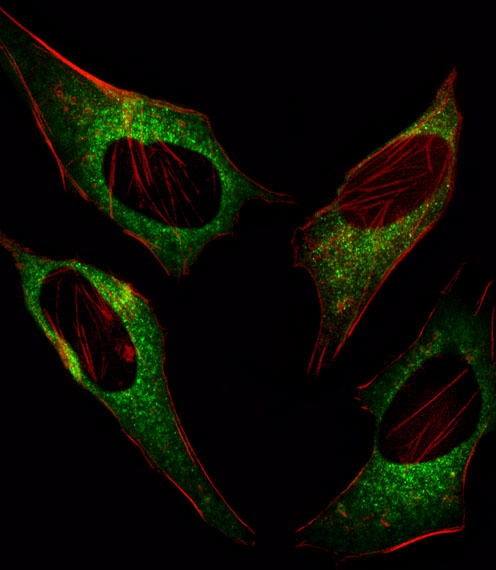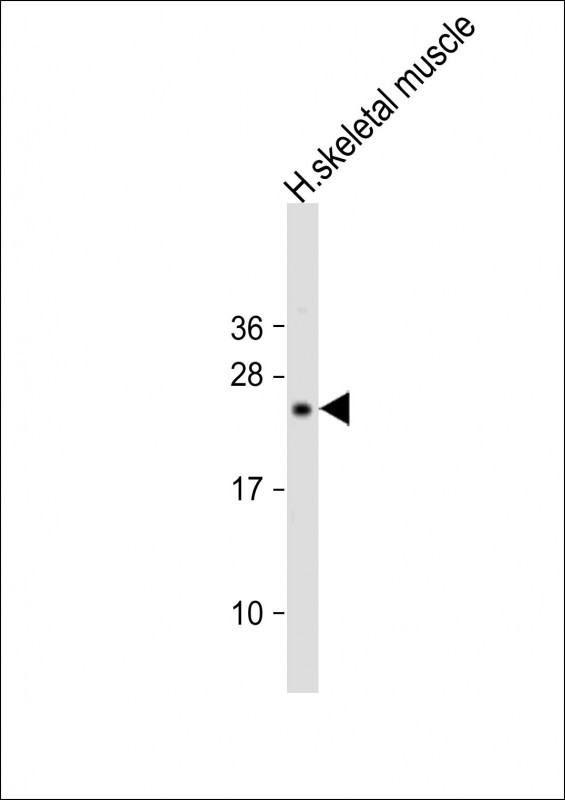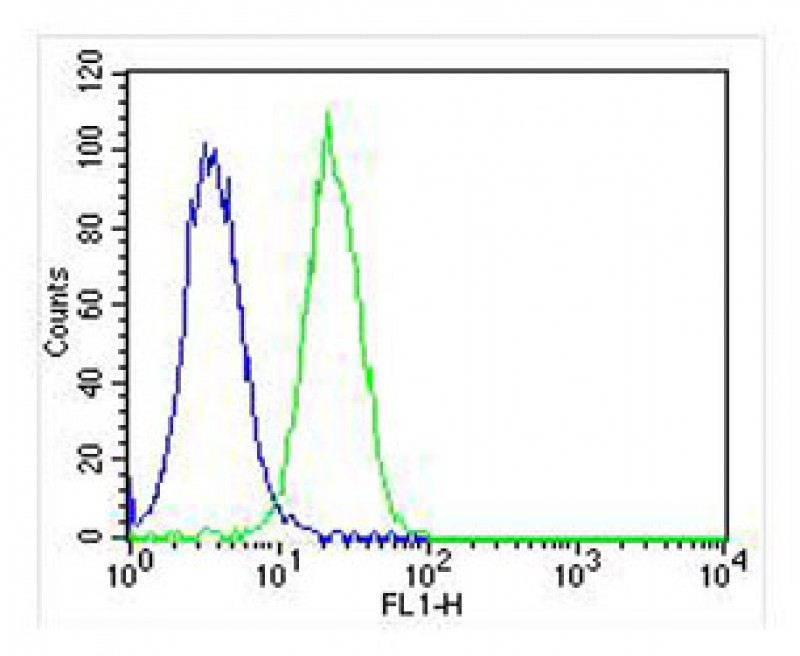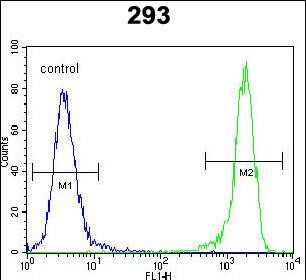DDIT3 Antibody (C-term A135)
Affinity Purified Rabbit Polyclonal Antibody (Pab)
- SPECIFICATION
- CITATIONS: 1
- PROTOCOLS
- BACKGROUND

Application
| IF, FC, WB, E |
|---|---|
| Primary Accession | P35638 |
| Other Accession | P35639, P14607, Q0IIB6, NP_004074 |
| Reactivity | Human, Mouse |
| Predicted | Bovine, Hamster |
| Host | Rabbit |
| Clonality | Polyclonal |
| Isotype | Rabbit IgG |
| Calculated MW | 19175 Da |
| Antigen Region | 120-149 aa |
| Gene ID | 1649 |
|---|---|
| Other Names | DNA damage-inducible transcript 3 protein, DDIT-3, C/EBP zeta, C/EBP-homologous protein, CHOP, C/EBP-homologous protein 10, CHOP-10, CCAAT/enhancer-binding protein homologous protein, Growth arrest and DNA damage-inducible protein GADD153, DDIT3, CHOP, CHOP10, GADD153 |
| Target/Specificity | This DDIT3 antibody is generated from rabbits immunized with a KLH conjugated synthetic peptide between 120-149 amino acids from the C-terminal region of human DDIT3. |
| Dilution | IF~~1:10~50 WB~~1:1000 FC~~1:10~50 |
| Format | Purified polyclonal antibody supplied in PBS with 0.09% (W/V) sodium azide. This antibody is purified through a protein A column, followed by peptide affinity purification. |
| Storage | Maintain refrigerated at 2-8°C for up to 2 weeks. For long term storage store at -20°C in small aliquots to prevent freeze-thaw cycles. |
| Precautions | DDIT3 Antibody (C-term A135) is for research use only and not for use in diagnostic or therapeutic procedures. |
| Name | DDIT3 |
|---|---|
| Synonyms | CHOP, CHOP10, GADD153 |
| Function | Multifunctional transcription factor in endoplasmic reticulum (ER) stress response (PubMed:15322075, PubMed:15775988, PubMed:19672300). Plays an essential role in the response to a wide variety of cell stresses and induces cell cycle arrest and apoptosis in response to ER stress (PubMed:15322075, PubMed:15775988). Plays a dual role both as an inhibitor of CCAAT/enhancer-binding protein (C/EBP) function and as an activator of other genes (By similarity). Acts as a dominant-negative regulator of C/EBP-induced transcription: dimerizes with members of the C/EBP family, impairs their association with C/EBP binding sites in the promoter regions, and inhibits the expression of C/EBP regulated genes (By similarity). Positively regulates the transcription of TRIB3, IL6, IL8, IL23, TNFRSF10B/DR5, PPP1R15A/GADD34, BBC3/PUMA, BCL2L11/BIM and ERO1L (PubMed:15775988, PubMed:17709599, PubMed:22761832, PubMed:20876114). Negatively regulates; expression of BCL2 and MYOD1, ATF4-dependent transcriptional activation of asparagine synthetase (ASNS), CEBPA-dependent transcriptional activation of hepcidin (HAMP) and CEBPB-mediated expression of peroxisome proliferator-activated receptor gamma (PPARG) (PubMed:18940792, PubMed:19672300, PubMed:20829347). Together with ATF4, mediates ER- mediated cell death by promoting expression of genes involved in cellular amino acid metabolic processes, mRNA translation and the unfolded protein response (UPR) in response to ER stress (By similarity). Inhibits the canonical Wnt signaling pathway by binding to TCF7L2/TCF4, impairing its DNA-binding properties and repressing its transcriptional activity (PubMed:16434966). Plays a regulatory role in the inflammatory response through the induction of caspase-11 (CASP4/CASP11) which induces the activation of caspase-1 (CASP1) and both these caspases increase the activation of pro-IL1B to mature IL1B which is involved in the inflammatory response (By similarity). Acts as a major regulator of postnatal neovascularization through regulation of endothelial nitric oxide synthase (NOS3)-related signaling (By similarity). |
| Cellular Location | Cytoplasm. Nucleus Note=Present in the cytoplasm under non-stressed conditions and ER stress leads to its nuclear accumulation |

Provided below are standard protocols that you may find useful for product applications.
Background
This gene encodes a member of the CCAAT/enhancer-binding protein (C/EBP) family of transcription factors. The protein functions as a dominant-negative inhibitor by forming heterodimers with other C/EBP members, such as C/EBP and LAP (liver activator protein), and preventing their DNA binding activity. The protein is implicated in adipogenesis and erythropoiesis, is activated by endoplasmic reticulum stress, and promotes apoptosis. Fusion of this gene and FUS on chromosome 16 or EWSR1 on chromosome 22 induced by translocation generates chimeric proteins in myxoid liposarcomas or Ewing sarcoma. Multiple alternatively spliced transcript variants encoding two isoforms with different length have been identified.
References
Park, S.H., et al. J. Immunol. 185(9):5522-5530(2010)
Goodall, J.C., et al. Proc. Natl. Acad. Sci. U.S.A. 107(41):17698-17703(2010)
Zhang, H.M., et al. J. Virol. 84(17):8446-8459(2010)
Cazanave, S.C., et al. Am. J. Physiol. Gastrointest. Liver Physiol. 299 (1), G236-G243 (2010) :
Wang, Y.L., et al. J. Exp. Clin. Cancer Res. 29, 54 (2010) :
If you have used an Abcepta product and would like to share how it has performed, please click on the "Submit Review" button and provide the requested information. Our staff will examine and post your review and contact you if needed.
If you have any additional inquiries please email technical services at tech@abcepta.com.















 Foundational characteristics of cancer include proliferation, angiogenesis, migration, evasion of apoptosis, and cellular immortality. Find key markers for these cellular processes and antibodies to detect them.
Foundational characteristics of cancer include proliferation, angiogenesis, migration, evasion of apoptosis, and cellular immortality. Find key markers for these cellular processes and antibodies to detect them. The SUMOplot™ Analysis Program predicts and scores sumoylation sites in your protein. SUMOylation is a post-translational modification involved in various cellular processes, such as nuclear-cytosolic transport, transcriptional regulation, apoptosis, protein stability, response to stress, and progression through the cell cycle.
The SUMOplot™ Analysis Program predicts and scores sumoylation sites in your protein. SUMOylation is a post-translational modification involved in various cellular processes, such as nuclear-cytosolic transport, transcriptional regulation, apoptosis, protein stability, response to stress, and progression through the cell cycle. The Autophagy Receptor Motif Plotter predicts and scores autophagy receptor binding sites in your protein. Identifying proteins connected to this pathway is critical to understanding the role of autophagy in physiological as well as pathological processes such as development, differentiation, neurodegenerative diseases, stress, infection, and cancer.
The Autophagy Receptor Motif Plotter predicts and scores autophagy receptor binding sites in your protein. Identifying proteins connected to this pathway is critical to understanding the role of autophagy in physiological as well as pathological processes such as development, differentiation, neurodegenerative diseases, stress, infection, and cancer.







